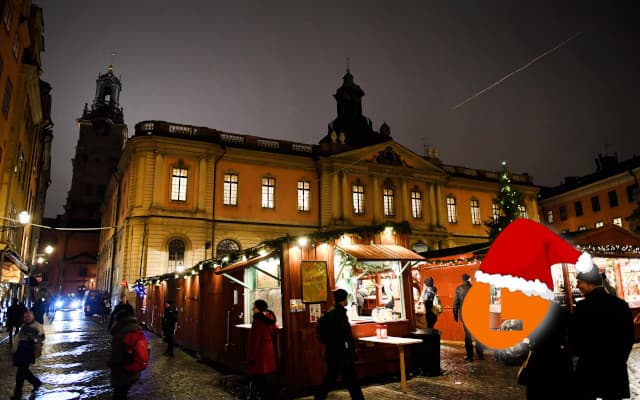#SwedishChristmas: Stepping back in time with Swedish Christmas markets

Every day until Christmas Eve, The Local explains the unique history behind Swedish Christmas traditions in our own Advent calendar.
This article is available to Members of The Local. Read more articles for Members here.
For centuries, Swedish Christmas markets have brought warmth and light to the darkest time of the year. Visiting a Swedish Christmas market (julmarknad) isn’t just a great way of becoming truly immersed in Sweden’s Christmas traditions, it may also be one of the best ways, short of a time machine, to experience what life was like in the past.
The history of the festive markets goes back to 14th century Germany, and Sweden appears to have adopted the Christmas market not long afterward. Much like today, the earliest Christmas markets were typically held in town squares throughout the month of December, and featured small stalls where merchants and craftspeople could sell their wares.
At Stortorget, Stockholm’s oldest square located in what is now known as Gamla Stan, markets were held at different times throughout the year as early as the 1300s, and there is evidence that one of these was held in connection with the feast day of St. Thomas the Apostle on December 21st. In 1523, during the first year of his reign, King Gustav Vasa established a permanent Christmas market at Stortorget. Though there have been periods over the centuries when the Stortorget julmarknad has not operated, it is still the oldest such market in Sweden and one of the oldest in Europe.
When the Stortorget julmarknad was established, the king took care to stipulate that only Swedish goods were sold, a tradition carried on today by Stockholms-Gillet, which has organized the market since 1915. There, as at many Christmas markets throughout Sweden, it is possible to find echoes of the past in both the atmosphere and the goods on sale.
Scents from traditional Swedish favourites like warm glögg, brända mandlar (candied almonds), and julgodis like knäck permeate the air just as they have in the past. The traditional foods and handicrafts offered for sale give a glimpse of life in the past, as well as the opportunity to incorporate them into modern life. The sense of stepping back in time is enhanced when attending a julmarknad at a historic location, or at one of Sweden’s fantastic open-air museums, such as Skansen in Stockholm.
Like other long-standing Swedish Christmas traditions, the secret to the timeless appeal of the julmarknad may be that it and all it encompasses bring warmth and light to the darkest time of the year.
Each day until Christmas Eve, we're looking at the story behind one Swedish festive tradition. Find the rest of our #SwedishChristmas series HERE.
Comments
See Also
For centuries, Swedish Christmas markets have brought warmth and light to the darkest time of the year. Visiting a Swedish Christmas market (julmarknad) isn’t just a great way of becoming truly immersed in Sweden’s Christmas traditions, it may also be one of the best ways, short of a time machine, to experience what life was like in the past.
The history of the festive markets goes back to 14th century Germany, and Sweden appears to have adopted the Christmas market not long afterward. Much like today, the earliest Christmas markets were typically held in town squares throughout the month of December, and featured small stalls where merchants and craftspeople could sell their wares.
At Stortorget, Stockholm’s oldest square located in what is now known as Gamla Stan, markets were held at different times throughout the year as early as the 1300s, and there is evidence that one of these was held in connection with the feast day of St. Thomas the Apostle on December 21st. In 1523, during the first year of his reign, King Gustav Vasa established a permanent Christmas market at Stortorget. Though there have been periods over the centuries when the Stortorget julmarknad has not operated, it is still the oldest such market in Sweden and one of the oldest in Europe.
When the Stortorget julmarknad was established, the king took care to stipulate that only Swedish goods were sold, a tradition carried on today by Stockholms-Gillet, which has organized the market since 1915. There, as at many Christmas markets throughout Sweden, it is possible to find echoes of the past in both the atmosphere and the goods on sale.
Scents from traditional Swedish favourites like warm glögg, brända mandlar (candied almonds), and julgodis like knäck permeate the air just as they have in the past. The traditional foods and handicrafts offered for sale give a glimpse of life in the past, as well as the opportunity to incorporate them into modern life. The sense of stepping back in time is enhanced when attending a julmarknad at a historic location, or at one of Sweden’s fantastic open-air museums, such as Skansen in Stockholm.
Like other long-standing Swedish Christmas traditions, the secret to the timeless appeal of the julmarknad may be that it and all it encompasses bring warmth and light to the darkest time of the year.
Join the conversation in our comments section below. Share your own views and experience and if you have a question or suggestion for our journalists then email us at [email protected].
Please keep comments civil, constructive and on topic – and make sure to read our terms of use before getting involved.
Please log in here to leave a comment.